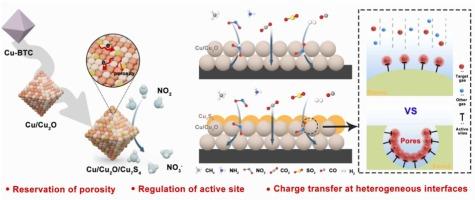多孔Cu/Cu2O/Cu7S4异质结的异质界面工程:在无线应用中实现高性能室温NO2传感
IF 3.7
1区 化学
Q1 CHEMISTRY, ANALYTICAL
引用次数: 0
摘要
三元金属/金属氧化物/硫化物异质结具有高孔隙率和大界面面积的特点,作为高性能化学电阻NO2传感器的材料具有很大的前景。在这项工作中,我们通过结合“自上而下”的蚀刻和“自下而上”的生长策略,成功地制备了具有可调节界面纳米结构和传感性能的原位工程mof衍生的Cu/Cu2O/Cu7S4异质结。Cu/Cu2O/Cu7S4异质结内具有良好定义的半相干异质界面和高孔隙率,通过降低传递阻抗,显著降低了界面处的电子传输障碍,从而加速了载流子转移,提高了活性位点目标气体探测的可达性。优化后的Cu/Cu2O/Cu7S4-40%传感器具有可定制的成分比,在室温下对50 ppm NO2气体的Ra/Rg响应值提高到54.84,快速响应时间仅为9 s。该传感器还具有超过7周的出色稳定性和1.8 ppb的极低检测限。此外,通过将蓝牙技术集成到我们的气体传感系统中,我们克服了传统电阻式传感器的局限性,在便携性、低功耗和用户友好性方面取得了实质性进展。这些改进标志着基于物联网(IoT)技术的新型室温气体传感器的开发和探索向前迈出了重要一步。本文章由计算机程序翻译,如有差异,请以英文原文为准。

Heterointerfaces engineering in porous Cu/Cu2O/Cu7S4 heterojunctions: Towards high-performance room-temperature NO2 sensing in wireless applications
Ternary metal/metal oxide/sulfide heterojunctions, featuring high porosity and large interfacial areas, hold great promise as materials for high-performance chemiresistive NO2 sensors. In this work, we successfully fabricated in-situ engineered MOF-derived Cu/Cu2O/Cu7S4 heterojunctions with adjustable interfacial nanostructures and sensing properties by combining “top-down” etching and “bottom-up” growth strategies. The integration of a well-defined semi-coherent heterointerface and high porosity within Cu/Cu2O/Cu7S4 heterojunctions significantly reduces the barrier to electron transmission at the interface by lowering the transfer impedance, thus accelerating carrier transfer and enhancing reachability for target gas detection at the active site. The optimized Cu/Cu2O/Cu7S4-40 % sensor with customizable component ratios, featuring an increased Ra/Rg response value of 54.84 for 50 ppm NO2 gas with a quick response time of just 9 s at room temperature. The sensor also demonstrates outstanding stability exceeding 7 weeks and an extremely low detection limit of 1.8 ppb. Furthermore, by integrating Bluetooth technology into our gas-sensing system, we overcame the limitations of conventional resistive transducers, achieving substantial advancements in terms of portability, low power consumption, and user-friendliness. These improvements mark a significant step forward in the development and exploration of novel room-temperature gas sensors based on Internet of Things (IoT) technology.
求助全文
通过发布文献求助,成功后即可免费获取论文全文。
去求助
来源期刊

Sensors and Actuators B: Chemical
工程技术-电化学
CiteScore
14.60
自引率
11.90%
发文量
1776
审稿时长
3.2 months
期刊介绍:
Sensors & Actuators, B: Chemical is an international journal focused on the research and development of chemical transducers. It covers chemical sensors and biosensors, chemical actuators, and analytical microsystems. The journal is interdisciplinary, aiming to publish original works showcasing substantial advancements beyond the current state of the art in these fields, with practical applicability to solving meaningful analytical problems. Review articles are accepted by invitation from an Editor of the journal.
 求助内容:
求助内容: 应助结果提醒方式:
应助结果提醒方式:


